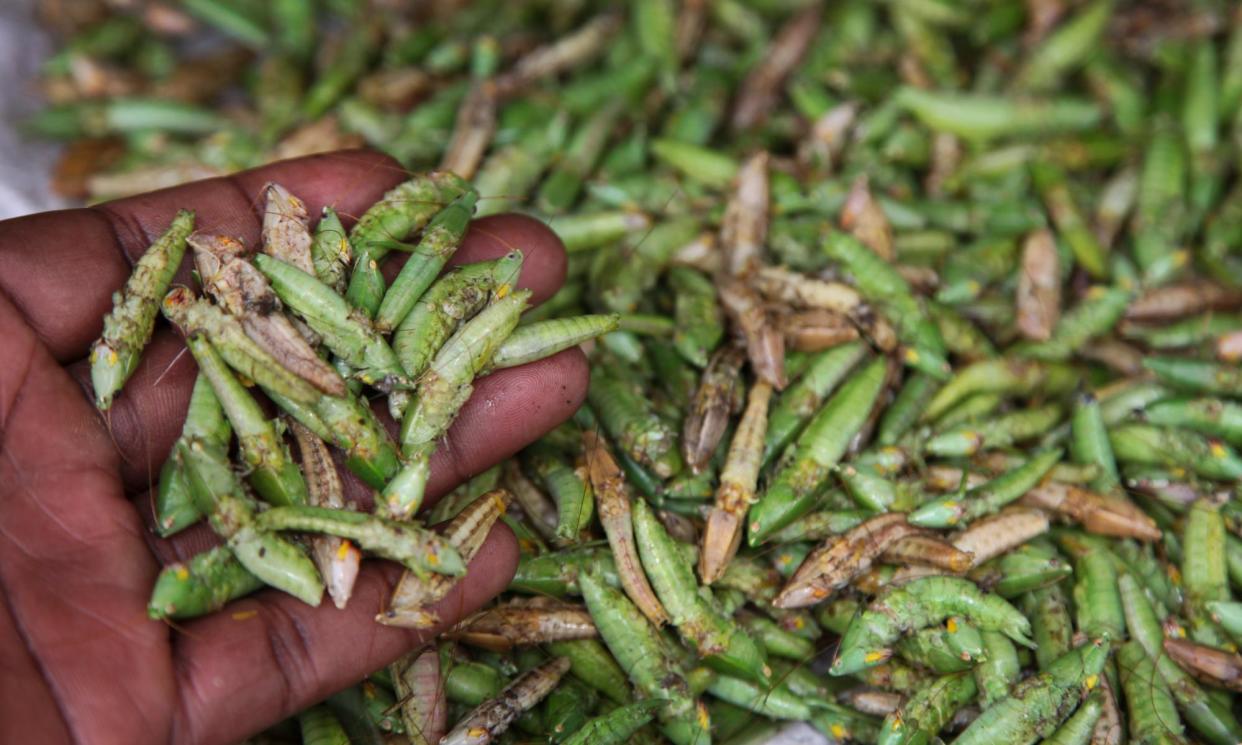Where have all the grasshoppers gone?: Uganda’s insect traders struggle to find protein-rich bugs

As night falls on Masaka’s industrial zone, Karim Damba’s work begins. He hauls large corrugated steel sheets into place and attaches them to empty oil drums lined with black polythene bags, propped up by long pieces of wood. At 8pm, he flicks on the fluorescent lights and waits for the grasshoppers to arrive.
“I have been doing this since 25 October,” says Damba, adjusting his skullcap. Damba is a grasshopper trapper in central Uganda. Between October and December his nights are spent waiting for the insects to hit the metal sheets and fall into the drums. The protein-rich bugs are wrapped and transported to market.
If the wind settles, it could be a good night for Damba and his fellow trappers. “Sometimes they come at midnight, sometimes at 5am,” he says.
The insects are a welcome part of Ugandans’ daily diet: they are high in fibre and omega-3 fatty acids and when fried and sprinkled with salt make a nutritious crunchy snack.
The insects, locally known as nsenene, appear twice a year, in April and May and from October to December. During these months, professional catchers set up their traps while excited children run around trying to catch the bugs before they fly away.
This year has been different, however. November is known as “musenene” – the month of the grasshopper – because swarms are seen, and caught, almost every day, particularly in central Uganda, their main breeding ground. But the insects appeared for just seven days last month. The no-show prompted concern at the highest levels in the country.
“This is Museneene [sic],” Ugandan President Yoweri Museveni wrote on X (formerly Twitter). “Where are they? Climate change? … I always wish the nsenene good luck.”
Grasshopper populations have been dwindling for years as the forests, grassland and swamps in which they feed and breed are destroyed. The country has lost almost a third of its forests in the last three decades. The central region has seen the most intense clearance of protected habitats.
This year has been the worst on record for grasshopper populations.
By 6am, Damba has only managed to fill half a sack. “It wasn’t a good night,” he says. On a good day during musenene he can fill up to 80 sacks, which can fetch about 60,000 Uganda shillings (£12.50) each. He’s got nowhere near that number this year.
The grasshoppers’ extinction may be looming. The environment has become hostile for them
Dr Giregon Olupot
After paying council taxes, rent for land to erect the traps, employing casual labour and using electricity every night, Damba is worried he may not get a return on his investment this year.
Quraish Katongole, head of the Old Masaka Basenene Association, which represents grasshopper trappers, says he is worried that one day the grasshoppers will disappear for good. “Every time we destroy forests, the weather changes. The wind just pushes them [grasshoppers] far away from here,” he says.
“We have spent money buying lighting bulbs, iron sheets, paying electricity and land. Electricity alone, if one has to switch on lights every day for two months, costs 1.7 million Uganda shillings. We borrowed money and we are in debt. Our hope is to get back the money to pay back debts.”
Dr Giregon Olupot, an academic and agricultural scientist at Makerere University in the capital, Kampala, says: “The grasshoppers’ extinction may be looming. The environment has become hostile for them. When they are gone, it spells doom for people who can’t afford alternative sources of protein but could easily access grasshoppers.”
On a drizzly grey November morning, grasshopper traders wait expectantly for the insects to arrive at Katwe market in Kampala. They are not happy with the day’s delivery – just three half-filled sacks.
“I am disappointed if this is what is coming from upcountry,” one trader remarks.
Related: At risk: 10 ways the changing climate is creating a health emergency
Traders haggle with harvesters over the price before settling at 400,000 shillings for each half sack – shortages have pushed up trading prices. The buyers sell the few insects in small cups for 15,000 shillings apiece. In abundant times, a cup would sell for about a quarter of that price.
Fewer grasshoppers mean less work for the market’s casual labourers whose job it is to clean the insects and pluck off their wings and legs before they are sold. “We are paid 700 shillings per cup of grasshoppers we clean. When the insects are not delivered we don’t work,” says Jesca Nanyanzi, who works at Katwe.
Early December saw an increase in the number of grasshoppers and this week, a bigger stash arrived at the market. But that didn’t help shopper Nelson Abamanya. “I usually buy fresh grasshoppers … but I have not been able to find them. Missing out is not how I planned to end the year.”

 Yahoo News
Yahoo News 
